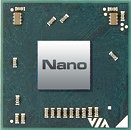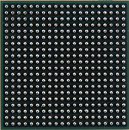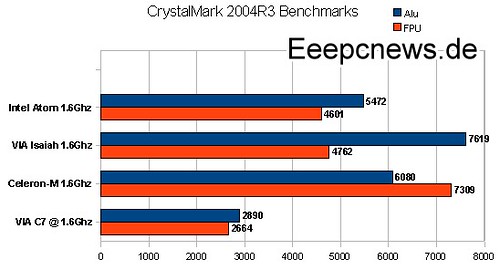malware
New Member
- Joined
- Nov 7, 2004
- Messages
- 5,422 (0.72/day)
- Location
- Bulgaria
| Processor | Intel Core 2 Quad Q6600 G0 VID: 1.2125 |
|---|---|
| Motherboard | GIGABYTE GA-P35-DS3P rev.2.0 |
| Cooling | Thermalright Ultra-120 eXtreme + Noctua NF-S12 Fan |
| Memory | 4x1 GB PQI DDR2 PC2-6400 |
| Video Card(s) | Colorful iGame Radeon HD 4890 1 GB GDDR5 |
| Storage | 2x 500 GB Seagate Barracuda 7200.11 32 MB RAID0 |
| Display(s) | BenQ G2400W 24-inch WideScreen LCD |
| Case | Cooler Master COSMOS RC-1000 (sold), Cooler Master HAF-932 (delivered) |
| Audio Device(s) | Creative X-Fi XtremeMusic + Logitech Z-5500 Digital THX |
| Power Supply | Chieftec CFT-1000G-DF 1kW |
| Software | Laptop: Lenovo 3000 N200 C2DT2310/3GB/120GB/GF7300/15.4"/Razer |
VIA Technologies, Inc, a leading innovator of power efficient x86 processor platforms, today announced the new VIA Nano processor family based on the VIA Isaiah Architecture. Building on the market-leading energy efficiency of the VIA C7 processor family, the VIA Nano processor family offers as much as four times the performance within the same power range to extend VIA's performance per watt leadership, while pin compatibility with VIA C7 processors will ensure a smooth transition for OEMs and motherboard vendors, and provides them with an easy upgrade path for current system or board designs.


The first 64-bit, superscalar, speculative out-of-order processors in VIA's x86 platform portfolio, VIA Nano processors have been specifically designed to revitalize traditional desktop and notebook PC markets, delivering truly optimized performance for the most demanding computing, entertainment and connectivity applications, including Blu-ray Disc HD video playback and the latest PC games, such as Crysis.
The VIA Nano processor family leverages Fujitsu's advanced 65 nanometer process technology for enhanced power efficiency, and augments that with aggressive power and thermal management features within the compact 21mm x 21mm nanoBGA2 package for an idle power as low as 100mW (0.1W), extending the reach of power efficient green and silent PCs, thin and light notebooks and mini-notes around the world.
"VIA Nano processors represent the next generation of x86 technology, providing the fundamental building blocks for a new genre of optimized computing solutions," said Wenchi Chen, President and CEO, VIA Technologies, Inc. "'Small is Beautiful' is more than a design strategy; it's our vision of where the PC market is heading and our new processors will help the market realize that dream."
VIA's 'nano' association also extends to VIA's signature silicon and platform design characteristics of power efficiency and form factor size reduction, as demonstrated by VIA's ultra compact Nano-ITX boards and the nanoBGA2 processor packaging used for the current VIA C7 processor family and the first generation of VIA Nano processors.
About the VIA Nano Processor Family
Initially to be launched in two skus, the VIA Nano L-series processors for mainstream desktop and mobile PC systems and the ultra low voltage U-series for small form factor desktop and ultra mobile devices such as mini-notes:

The VIA Nano processor family boasts the highly efficient VIA V4 bus interface and brings a host of technology firsts to VIA's processor platform line-up, including:
VIA Nano Processor Availability
VIA Nano processors are available now for OEMs and motherboard vendors, while systems featuring VIA Nano processors are expected to market in Q3 2008.
View at TechPowerUp Main Site


The first 64-bit, superscalar, speculative out-of-order processors in VIA's x86 platform portfolio, VIA Nano processors have been specifically designed to revitalize traditional desktop and notebook PC markets, delivering truly optimized performance for the most demanding computing, entertainment and connectivity applications, including Blu-ray Disc HD video playback and the latest PC games, such as Crysis.
The VIA Nano processor family leverages Fujitsu's advanced 65 nanometer process technology for enhanced power efficiency, and augments that with aggressive power and thermal management features within the compact 21mm x 21mm nanoBGA2 package for an idle power as low as 100mW (0.1W), extending the reach of power efficient green and silent PCs, thin and light notebooks and mini-notes around the world.
"VIA Nano processors represent the next generation of x86 technology, providing the fundamental building blocks for a new genre of optimized computing solutions," said Wenchi Chen, President and CEO, VIA Technologies, Inc. "'Small is Beautiful' is more than a design strategy; it's our vision of where the PC market is heading and our new processors will help the market realize that dream."
VIA's 'nano' association also extends to VIA's signature silicon and platform design characteristics of power efficiency and form factor size reduction, as demonstrated by VIA's ultra compact Nano-ITX boards and the nanoBGA2 processor packaging used for the current VIA C7 processor family and the first generation of VIA Nano processors.
About the VIA Nano Processor Family
Initially to be launched in two skus, the VIA Nano L-series processors for mainstream desktop and mobile PC systems and the ultra low voltage U-series for small form factor desktop and ultra mobile devices such as mini-notes:

The VIA Nano processor family boasts the highly efficient VIA V4 bus interface and brings a host of technology firsts to VIA's processor platform line-up, including:
- 64-bit Superscalar Speculative Out-Of-Order MicroArchitecture: Supports a full 64-bit instruction set and provides for macro-fusion and micro-fusion functionality, and sophisticated branch prediction for greater processor efficiency and performance.
- High-Performance Computation and Media Processing: The high-speed, low power VIA V4 Front Side Bus starting at 800MHz, plus a high floating point unit, support for new SSE instructions, and two 64KB L1 caches and 1MB exclusive L2 cache with 16-way associativity gives a big boost to multimedia performance.
- Advanced Power and Thermal Management: Aggressive management of active power includes support for the new "C6" power state, Adaptive PowerSaver Technology, new circuit techniques and mechanisms for managing the die temperature, reducing power draw and improving thermal management.
- Scalable Upgrade to VIA C7 Processor: Pin-to-pin compatibility with current VIA C7 processors enables a smooth transition for OEMs and mainboard vendors, enabling them to offer a wider range of products for different markets with a single board or system design.
- Greener Technology: In addition to full compliance with RoHS and WEEE regulations, product manufacturing will be halogen-free and lead-free at launch, helping to promote a cleaner environment and more sustainable computing.
- Enhanced VIA PadLock Security Engine: Industry-leading on-die hardware cryptographic acceleration and security features, including dual quantum random number generators, an AES Encryption Engine, NX-bit, and SHA-1 and SHA-256 hashing.
VIA Nano Processor Availability
VIA Nano processors are available now for OEMs and motherboard vendors, while systems featuring VIA Nano processors are expected to market in Q3 2008.
View at TechPowerUp Main Site







 to us for going offtopic.
to us for going offtopic.
